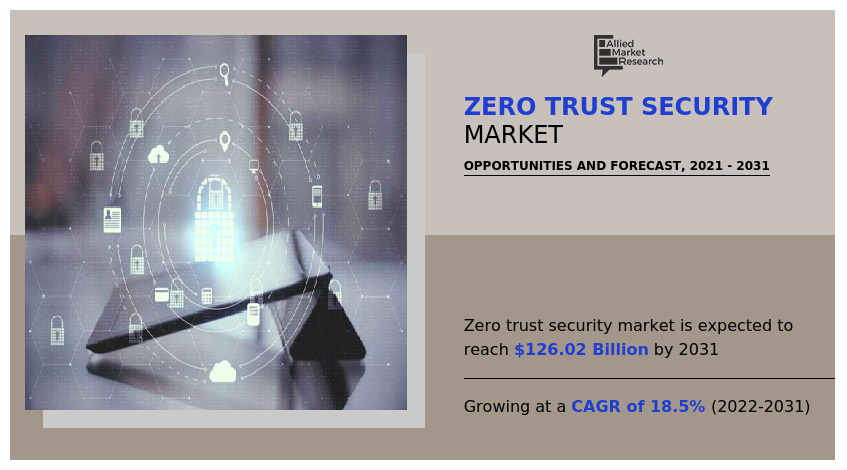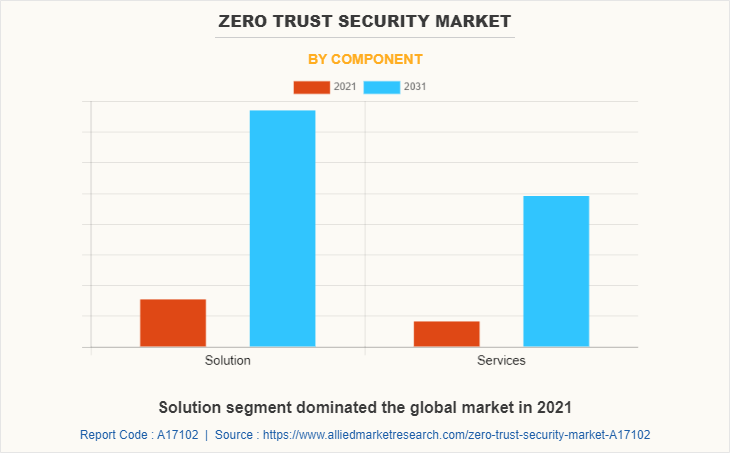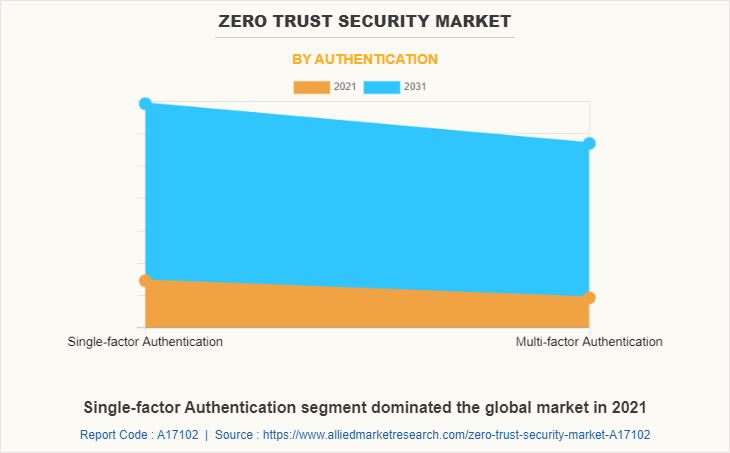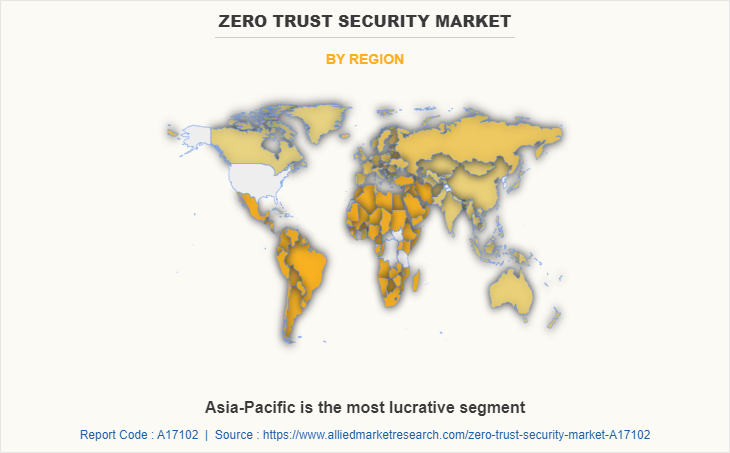Zero Trust Security Market Overview
The global zero trust security market was valued at USD 23.61 billion in 2021, and is projected to reach USD 126.02 billion by 2031, growing at a CAGR of 18.5% from 2022 to 2031. Major drivers of the market growth include rise in security breaches targeting business applications, rise in malware and phishing threats among enterprises, and surge in demand for cloud-based zero trust security solutions.
Key Market Trends & Insights
- By component, the services segment is expected to witness the highest growth rate during the forecast period
- By authentication, the multi-factor authentication segment is expected to witness the highest growth rate during the forecast period
- Region wise, Asia-Pacific is expected to witness significant growth in the upcoming years.
Market Size & Forecast
- 2021 Market Size: USD 23.61 Billion
- 2031 Projected Market Size: USD 126.02 Billion
- Compound Annual Growth Rate (CAGR) (2022-2031): 18.5%

The potential impact of internal and external threats has grown as a result of the ongoing development of technology and internet connectivity over time. Records-exposed rate and data breaches have increased over time, according to an analysis of documented attacks and incursions. In addition, assaults such as disruptive and complicated WannaCry ransomware enable unauthorized access and cause data loss as well as lost revenue. Vulnerability assessment tools are now necessary to scan for and discover internal and external vulnerabilities, due to the average cost of a data breach in a corporation being $4 Billion.
The risk assessment sector is investing more in cutting-edge technology such as analytics and Artificial Intelligence (AI) as a result of the evolving cyber threat landscape and its implications. Furthermore, a decline in malicious assaults has been seen as a result of ongoing investments in cutting-edge vulnerability management technologies. his suggests that the end-users are more prepared for tackling vulnerability attacks, and with the increased investments as an effort toward security strategy, the zero-trust security market is expected to register significant growth over the forecast period.
Zero Trust Security Market Segment Overview
The zero trust security market is segmented into Component, Deployment Model, Enterprise Size, Authentication and Industry Vertical.Depending on component, the market is divided into solution and services. Depending on deployment model, the market is divided into on-premise and cloud. Depending on enterprise size, the market is divided into SMEs and large enterprise. Depending on authentication, the market is divided into single-factor authentication and multi-factor authentication. On the basis of industry vertical, the market is divided into BFSI, government, IT and telecom, manufacturing, healthcare, retail, energy and utilities, and others. On the basis of region, it is analyzed across North America, Europe, Asia-Pacific, and LAMEA.
On the basis of component, the solution segment dominated the zero trust security market Share in 2021, and is expected to maintain the dominance in the upcoming years. The Zero Trust Architecture solutions include advanced persistent threat protection, cybersecurity risk management, compliance management, security operations, identity & access management, and other zero trust security solutions. However, the services is expected to witness the highest growth rate during the forecast period. The growth of this market is also fueled by the rise in zero trust security services adoption among small and medium-sized businesses (SMEs) and the rise in security threat.

On the basis of authentication, the single-factor authentication segment dominated the zero trust security market in 2021. Single-Factor Authentication (SFA) is a method of logging users into resources by having them present only one way of verifying their identity. However, the multi-factor authentication segment is expected to witness the highest growth rate during the zero trust security market forecast period, as the user is required to provide two or more verification factors to access any online account, an application, or a VPN.

North America is a rapidly growing region in the global zero trust security industry, in terms of technological advancements and adoption. It possesses well-equipped infrastructure and the ability to afford Zero Trust Network security solutions. Furthermore, owing to rise in competition between cloud-based service providers in North America, key players are providing more security for data by ensuring quick access and greater outreach of their services to the clients, which drives the growth of the zero trust security market in this region.

Top Impacting Factors
Rise in Security Breaches Targeting Business Applications
- The majority of firms worldwide have implemented a number of digital transformation efforts. For instance, despite the economic uncertainties brought on by COVID-19, 61% of IT and DevOps leaders intend to enhance their digital transformation initiatives and projects, according to a recent report by OpsRamp, a SaaS platform for IT Operations management. More organizations are embracing applications to offer services to their clients as part of the digital transformation projects. The need for application security solutions is being driven by hackers who primarily target these types of apps. For instance, Mar Marriott International, Inc., a multinational American corporation, suffered a hack in March 2020, resulting in the theft of more over 5 Billion client details.
Rise in Malware and Phishing Threats Among Enterprises
Malware, such as viruses and Trojan horses, now has a substantially greater ability to penetrate, control, or harm entire electronic information networks. Malware is a common tool used by online criminals to seize control of machines or devices in order to profit financially. This is done to directly use the device to carry out fraudulent transactions or other bad deeds.
Furthermore, businesses in the BFSI, healthcare, and government sectors are particularly vulnerable to such attacks due to the significance of the data generated in these industries. As a result, the threat of malware and phishing attacks has increased, which is a significant factor in the expansion of the zero trust security market. Additionally, the COVID-19 pandemic has increased the frequency of malware attacks on the databases of significant businesses, necessitating the need to enhance database security and driving the global growth of the zero trust security industry.
Which are the Leading Companies in Zero Trust Security
The following are the leading companies in the zero trust security market. It offers an in-depth analysis of the zero trust security market—covering market share, trends, and future projections—to identify potential investment opportunities.
Cisco
Akamai
IBM
ZScaler
VMware
Microsoft
Cloudflare
Google
Cyxtera Technologies
SonicWall
Palo Alto Networks
Check Point Software Technologies
Trend Micro
Symantec Corp.
FireEye
McAfee Corp.
Forcepoint.
What are the Key Benefits for Stakeholders
This report provides a quantitative analysis of the market segments, current trends, estimations, and dynamics of the zero trust security market analysis from 2021 to 2031 to identify the prevailing zero trust security market opportunities.
The market research is offered along with information related to key drivers, restraints, and opportunities.
Porter's five forces analysis highlights the potency of buyers and suppliers to enable stakeholders make profit-oriented business decisions and strengthen their supplier-buyer network.
In-depth analysis of the zero trust security market segmentation assists to determine the prevailing market opportunities.
Major countries in each region are mapped according to their revenue contribution to the global market.
Market player positioning facilitates benchmarking and provides a clear understanding of the present position of the market players.
The report includes the analysis of the regional as well as global zero trust security market trends, key players, market segments, application areas, and market growth strategies.
Zero Trust Security Market Report Highlights
| Aspects | Details |
| By Component |
|
| By Deployment Model |
|
| By Enterprise Size |
|
| By Authentication |
|
| By Industry Vertical |
|
| By Region |
|
| Key Market Players | Palo Alto Networks, FireEye, Inc., VMware, Inc., Cyxtera Technologies, Trend Micro, Inc., IBM, Cloudflare, Microsoft Corporation, Zscaler, Check Point Software Technologies, Symantec Corp., Google, Cisco Systems Inc., McAfee Corp., SonicWall, Akamai Technologies Inc. |
Analyst Review
The zero trust security market is expanding and undergoing significant change. Organizations must now find, enhance, and fix the security of zero trust in order to maintain the security of their applications. As cybercriminals' attacks on businesses have gotten more serious, it is more important than ever to keep organizations secure. Such attacks on enterprises run the risk of exposing user data to theft and misuse by hackers, which might result in a loss of billions of dollars.
Zero trust security is increasingly being used worldwide. For instance, according to a recent survey, over 105 billion applications were downloaded in 2018. There are a variety of application security risks that both users and app developers need to be aware of and handle. Due to rise in usage and demand for applications for distant learning, teleconferencing, online gaming, healthcare, e-commerce, and entertainment, the COVID-19 pandemic has also greatly accelerated the growth rate of the zero trust security market.
The CXOs continued by stating that there are numerous regional and international suppliers competing in the zero trust security industry on grounds such as price, dependability, features, and support services. Rapid developments in zero trust security offerings have an impact on market expansion, whereas COVID-19 conditions and industry development have an impact on vendor performance. Due to rivalry, industry players are providing improved application security products and services to enhance the client experience. For instance, in September 2020, StackHawk, the software-as-a-service startup announced its general availability to any company that intends to deliver secure software. StackHawk solution empowers software engineers to find and fix application security bugs before they hit production.
The zero trust security market size is estimated to grow from $23.61 billion in 2021, and is projected to reach $126.02 billion by 2031
The zero trust security market is driven by increasing cyber threats, remote work adoption, regulatory compliance demands, and the rise of cloud-based infrastructure.
The global zero trust security market is projected to grow at a compound annual growth rate of 18.5% from 2022 to 2031 to reach USD 126.02 billion by 2031
North America dominated the global zero trust security market in 2021.
Key players operating in the market include Cisco, Akamai, IBM, ZScaler, VMware, Microsoft, Cloudflare, Google, Cyxtera Technologies, SonicWall, Palo Alto Networks, Check Point Software Technologies, Trend Micro, Inc., Symantec Corp., FireEye, Inc., McAfee Corp.
Loading Table Of Content...



